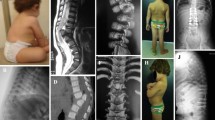Abstract
Multilevel laminectomy in children has a significant rate of postoperative spinal deformity. To decrease the incidence of this complication, the use of osteoplastic laminotomy is advocated to minimise the risk of spinal deformity by preserving the normal architecture of the spine. In this retrospective study, a 10-year series of a paediatric population undergoing multilevel osteoplastic laminotomy is reviewed to determine the incidence, especially in contrast to laminectomies, and to identify factors that affect the occurrence of spinal column deformity. Seventy patients (mean age 4.2 years) underwent multilevel osteoplastic laminotomy for congenital anomalies or removal of spinal tumours. All patients had a clinical and radiographic examination preoperatively, 12 months postoperatively and at follow-up. Mean follow-up was 5.3 years (range 3–12.6 years). Nineteen patients (27%) had a new or progressive spinal deformity. There was an increased incidence in patients who had surgery for spinal tumours (P < 0.05), surgery of the cervical spine (P < 0.01), and who had more than five levels of the spine included (P < 0.05). A review of the literature on children with multilevel laminectomy (n = 330), the incidence of spinal deformity found a significantly higher (46%) compared to our study group. This study demonstrates that osteoplastic laminotomy was found to be very effective in decreasing the incidence of spinal deformities after spinal-canal surgery for spinal-cord tumours or congenital anomalies in children and adolescents. The choice of an anatomical reconstructive surgical technique such as osteoplastic laminotomy seems to be essential to minimise secondary problems due to the surgical technique itself. Nevertheless, growing patients should be followed up for several years after the initial operation for early detection and consequent management of any possible deformity of the spinal column.
Résumé
La laminectomie étagée chez l’enfant entraîne un taux important de déformations rachidiennes post-opératoires. Pour diminuer l’incidence de cette complication nous utilisons la laminotomie ostéoplastique qui sert à préserver une architecture normale du rachis. Dans cette étude rétrospective, une série d’enfants a été revue sur 10 ans de façon à déterminer l’incidence de ces déformations en comparaison avec la laminectomie. 70 patients (âge moyen 4,2 ans) ont bénéficié d’une laminotomie ostéoplastique pour anomalie congénitale ou pour résection tumorale. Les patients ont bénéficié d’un suivi clinique et radiographique, le suivi moyen a été de 5,3 ans (de 3 à 12,6 ans). 19 patients (27%) ont présenté une déformation progressive du rachis. Celle-ci est plus importante dans les résections pour tumeurs (P < 0.05) et au niveau de la colonne cervicale (P < 0.01) et lorsque 5 niveaux ont été inclus sur le plan chirurgical (P < 0.05). La revue de la littérature à propos de 330 laminectomies a montré une incidence des déformations rachidiennes de 46% comparé au 27% de notre série. Cette étude démontre que la laminotomie ostoplastique est une chirurgie qui diminue l’incidence des déformations rachidiennes après chirurgie pour malformation ou tumeur. Néanmoins, ces patients devront être surveillés pendant toute la période de croissance de façon à détecter une déformation éventuelle.
Similar content being viewed by others
References
Boersma G (1969) Curvatures of the spine following laminectomies in children. Born, Amsterdam
Cattell HS, Clark GL Jr (1978) Cervical kyphosis and instability following multiple laminectomies in children. J Bone Joint Surg Am 49:713–720
Cobb J (1948) Outline of the study of scoliosis. AAOS Instr Course Lect 5:261–275
Dubousset J (1973) Paper presented to neurosurgical congress of infants. In Rougerie, L (ed) Compressions medullaires non-traumatique de l’enfant. Paris
Fraser RD, Patterson TL (1977) Orthopaedic aspects of spinal cord tumors in children. J Bone Joint Surg Br 59:143–146
Haft H, Ransohoff J, Carter S (1959) Spinal cord tumors in children. Pediatrics 23:1152–1159
Houten JK, Weiner HL (2000) Pediatric intramedullary spine cord tumors: special considerations. J Neurosurg Oncol 47:225–230
Kawai S, Sunago K, Doi K, Saika M, Tagucchi T (1988) Cervical laminoplasty (Hattori’s method). Spine 13:1245–1250
Lonstein JE (1978) Postlaminectomy kyphosis. In: Chou SN, Seljeskog EL (eds) Spinal deformities and neurological dysfunction. Raven Press, New York
Lunardi P, Licastro G, Missori P, Ferrante L, Fortuna A (1993) Management of intramedullary tumors in children. Acta Neurochir 120:59–65
Miyazaki K, Tada K, Matsuda Y, Okuno M, Yasuda T, Murakami H (1998) Posterior extensive simultanous multisegment decompression with posterolateral fusion for cervical instability and kyphotic and/or s-shaped deformities. Spine 14:1160–1170
Milhorat TH (1978) Pediatric neurosurgery. Contemp Neurol Ser 16:611–623
Munechica Y (1973) Influence of laminectomy on the stability of the spine: an experimental study with special reference to the extent of laminectomy and the resection of the intervertebral joint. J Jpn Orthop Assoc 47:111–126
Panjabi MM, White AA III, Johnson RM (1975) Cervical spine mechanics as a function of transection of components. J Biomech 8:327–336
Papagelopoulos PJ, Peterson HA, Ebersold MJ, Emmanuel PR, Choudhury SN, Quast LM (1997) Spinal deformity and instability after lumbar or thoracolumbar laminectomy for intraspinal tumors in children and young adults. Spine 22:442–451
Raimondi AJ, Guitierrez FA, Di Rocco C (1976) Laminectomy and total reconstruction of the posterior spinal arch for spinal canal surgery in childhood. J Neurosurg 45:555–560
Sharma M, Langrana N, Rodriguez J (1995) Role of ligaments and facets in lumbar spinal stability. Spine 20:887–900
Smith GW, Robinson RA (1958) The treatment of certain cervical-spine disorders by anterior removal of the intervertebral disc and interbody fusion. J Bone Joint Surg Am 56:607–624
Stagnara P, De Mauroy JC, Dran G, Gonon GP, Costanzo G, Dimnet J, Pasquet A (1982) Reciprocal angulation of vertebral bodies in a sagittal plane: approach to reference for the evaluation of kyphosis and lordosis. Spine 7:335–342
Tachdjian MO, Matson DD (1965) Orthopaedic aspects of intraspinal tumors in infants and children. J Bone Joint Surg Am 47:223–248
Yasuoka S, Peterson HA, MacCarthy CS (1982) Incidence of spinal column deformity after multilevel laminectomy in children and adults. J Neurosurg 57:441–445
Author information
Authors and Affiliations
Corresponding author
Rights and permissions
About this article
Cite this article
Raab, P., Juergen, K., Gloger, H. et al. Spinal deformity after multilevel osteoplastic laminotomy. International Orthopaedics (SICO 32, 355–359 (2008). https://doi.org/10.1007/s00264-007-0325-x
Received:
Revised:
Accepted:
Published:
Issue Date:
DOI: https://doi.org/10.1007/s00264-007-0325-x




